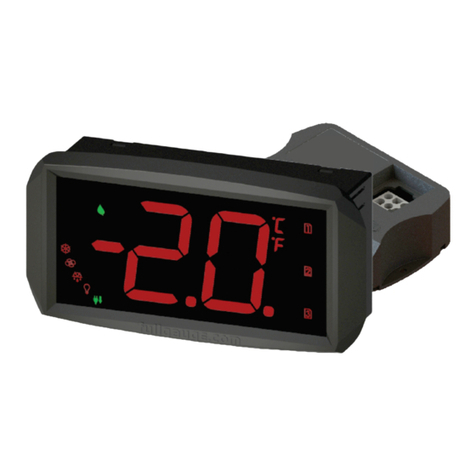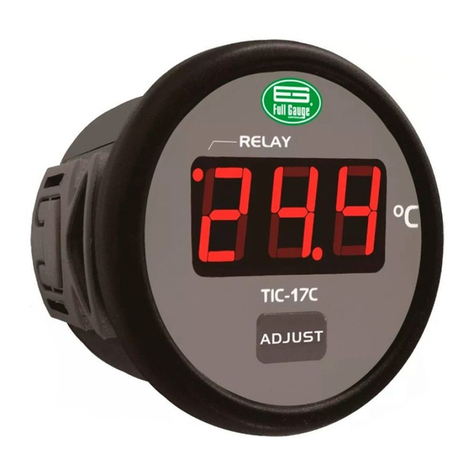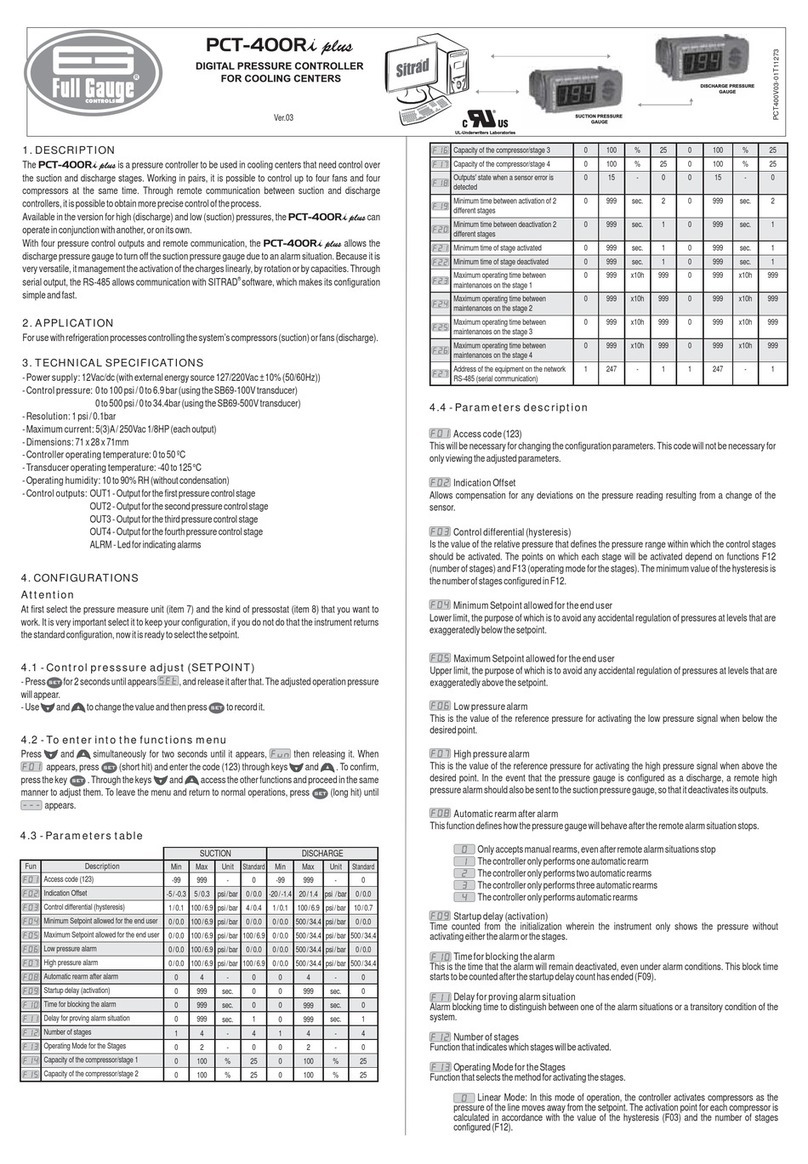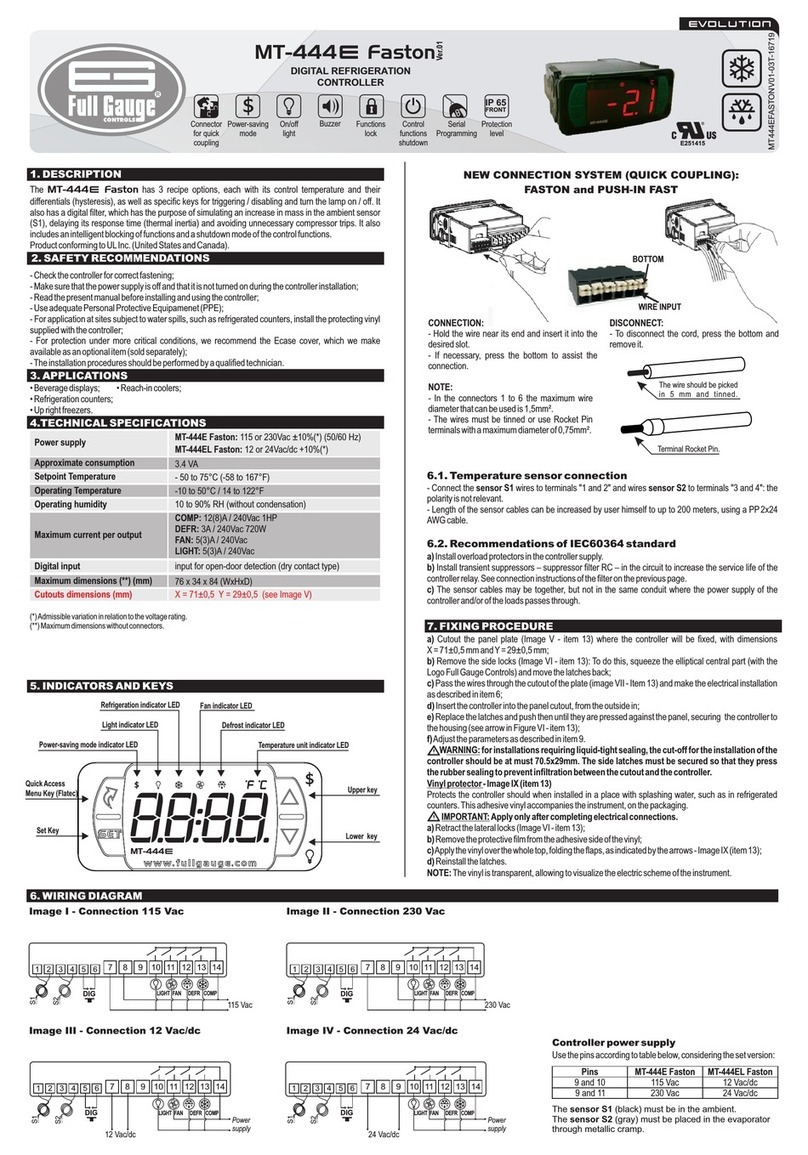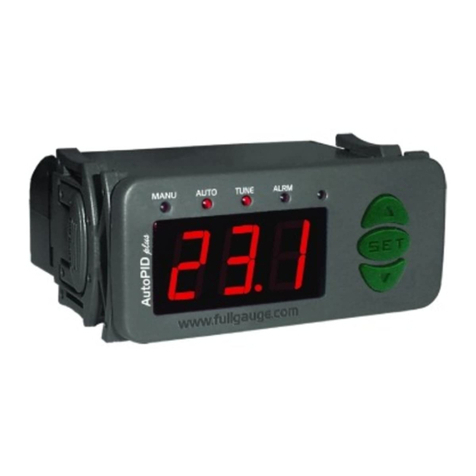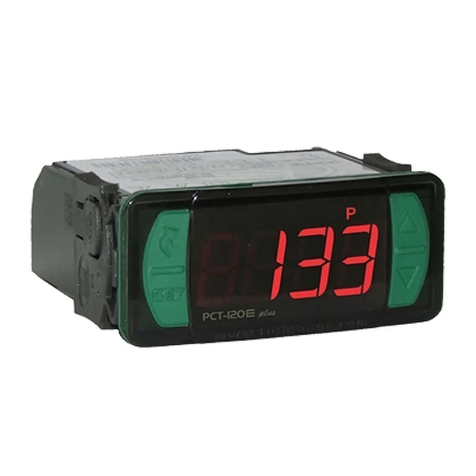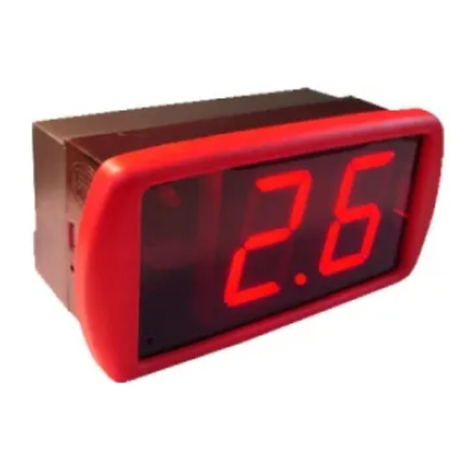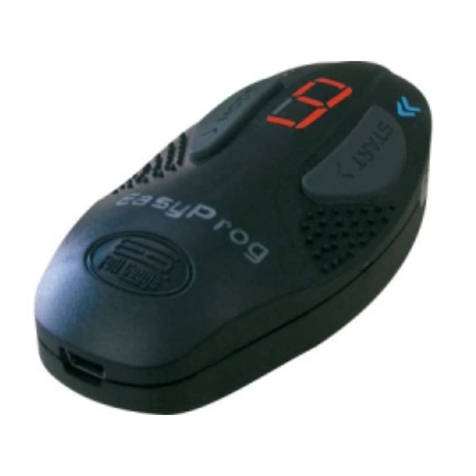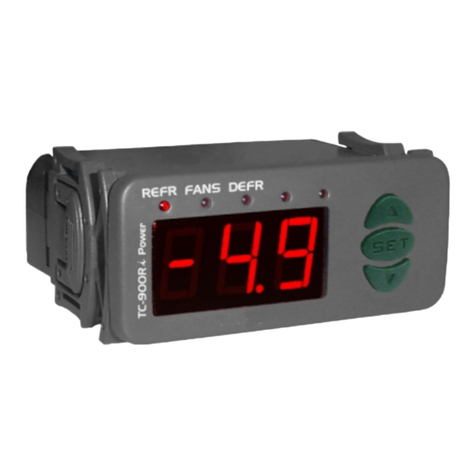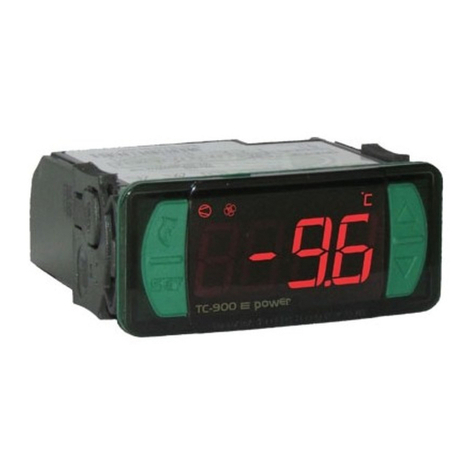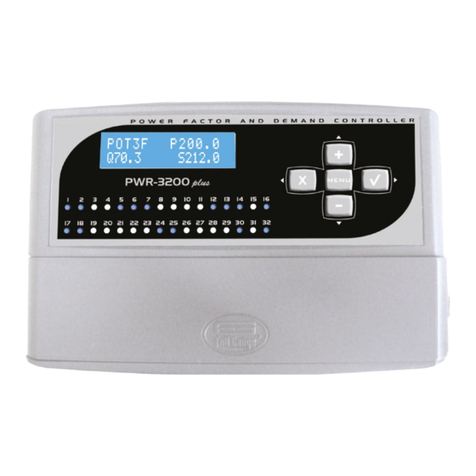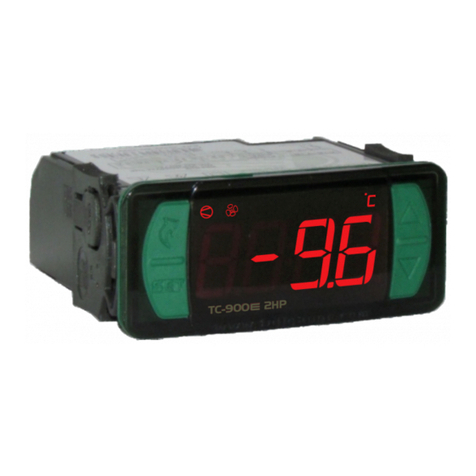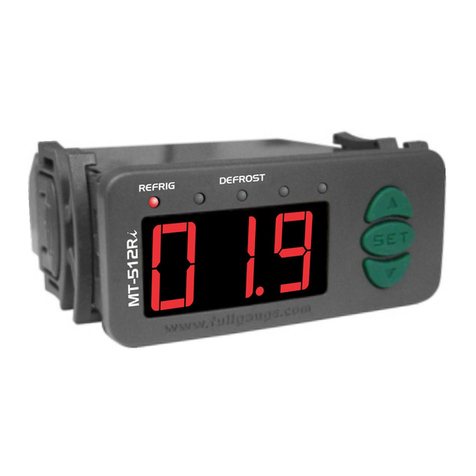F03 - Using Presets:
Allows configuration of the controller so as whether or not to use the presets:
[no,,]- No: If configured this way, the instrument will not use the preset values in the control routines.
For this purpose, the setpoint[SP,,] will be used, adjusted via the quick access menu. The control
differential to be used shall be the same as in preset [rc1,], F06 “OUT1 output control differential
([rc1,])”. The cooling time to be used shall be the same as in preset [rc1,], F07 “OUT1 output
cooling time ([rc1,])”. Defrost time to be used will be the same as in preset 1, F08 “OUT1 output
defrost time ([rc1,])”.
The value configured in [SP,,] may be adjusted between F13 “Minimum setpoint allowed to the end
user” and F14 “Maximum setpoint allowed to the end user”.
In this configuration, the controller will not indicate which preset is enabled.
[yEs,]- Yes: Selection of presets will be made through the quick access menu, in the same way as for
adjusting the setpoint. In this configuration, the controller will indicate in the display which preset is
enabled, [rc1,] or [rc2,]. If configured this way, in the control routines the instrument will use the
values of setpoint, control differential, cooling time and defrost time configured in the parameters table.
F04 - Output operating mode OUT1:
Selects the out1 output operating mode:
[,,,0]- Cooling
[,,,1]- Heating
F05 - Operation setpoint ( ): [Rc1,]
It is the reference value for temperature control, that is, the temperature to be maintained in a controlled
environment when preset ([rc1,]) is used.
F06 - Control differential (Hysteresis) ( ):[Rc1,]
It is the difference in temperature (hysteresis) between TURNING ON and OFF the cooling (or heating)
when recipe ([rc1,]) is used.
Example: One wants to control the temperature at 4.0 °C with a differential of 1.0 °C. Therefore, the
cooling is switched off at 4.0 °C and switched back on at 5.0 °C (4.0 + 1.0).
Temperature [°C]
Setpoint
Cooling
Setpoint + Hysteresis
Time [S]
Relay Off
Relay On
4°C
5°C
Temperature [°C]
Setpoint
Heating
Setpoint - Hysteresis
Time [S]
4°C
5°C
Relay Off
Relay On
6.5. Parameters table
F01- Access code 123 (one hundred and twenty-three):
This is required when intending to change the configuration parameters. Entering of this code is not
required if the intention is just visualizing the parameters adjusted.
It allows entering of the expected access codes:
[,123]- Allows access for changing the table parameters.
[,231]- Allows configuring of the unit of measurement [,=f,] or [,=C,].
[,231]- To select the unit in which the instrument will operate enter the function[,F01] using the
access code[,231]then press the/key. Then, select the unit desired [,=C,] or[,=F,]using
the< >keys; to confirm press /. or
NOTE: Every time the unit is changed, the parameters should be reset, since they assume the
‘standard’ values of the parameter’s table.
F02 - Sensor indication displacement (offset):
Allows compensation for any temperature deviations from sensor replacement or change in the cable
length.
6.5.1. Description of parameters
Access code 123
Sensor indication displacement (offset)
Using Presets
Output operating mode OUT1
Operation setpoint (rc1)
Control differential (Hysteresis) (rc1)
Cooling time (interval between defrosts) (rc1)
Defrost time (rc1)
Operation setpoint (rc2)
Control differential (Hysteresis) (rc2)
Cooling time (interval between defrosts) (rc2)
Defrost time (rc2)
Minimum setpoint allowed to the end user
Maximum setpoint allowed to the end user
Minimum OUT1 output time on
Minimum OUT1 output time off
Initial status when energizing the instrument
Temperature indication locked during defrost
Instrument energization delay
Compressor status with the sensor damaged
Compressor time on in case of error
Compressor time off in case of error
Maximum Compressor on without reaching setpoint
Low temperature alarm
High temperature alarm
OUT2 output operating mode
Alarm inhibition time when energizing the controller
Alarm inhibition time by temperature
Enable buzzer
Digital input operating mode
Output on time in OUT2 alarm status
Output off time in OUT2 alarm status
Open door time for alarm
Operating mode of the digital filter
Digital filter intensity applied to the sensor
Functions lockdown
Time for functions lockdown
Control functions shutdown
[,F01]
[,F02]
[,F03]
[,F04]
[,F05]
[,F06]
[,F07]
[,F08]
[,F09]
[,F10]
[,F11]
[,F12]
[,F13]
[,F14]
[,F15]
[,F16]
[,f17]
[,f18]
[,F19]
[,F20]
[,F21]
[,F22]
[,F23]
[,F24]
[,F25]
[,F26]
[,F27]
[,F28]
[,F29]
[,F30]
[,f31]
[,f32]
[,F33]
[,F34]
[,f35]
[,f36]
[,f37]
[,f38]
Fun Min Max Unit
CELSIUS FAHRENHEIT
Min Max Unit
Standard
-
-5.0
no
0-cool.
-50
0.1
1
0(no)
-50
0.1
1
0(no)
-50
-50
0(no)
0(no)
0-cool.
no
0(no)
0
1
1
0(no)
-50
-50
1
0(no)
0(no)
0(off)
0(no)
0
0
0(no)
0
0(no)
0
15
0(no)
-
-9
no
0-cool.
-58
1
1
0(no)
-58
1
1
0(no)
-58
-58
0(no)
0(no)
0-cool.
no
0(no)
0
1
1
0(no)
-58
-58
1
0(no)
0(no)
0(off)
0(no)
0
0
0(no)
0
0(no)
0
15
0(no)
-
5.0
yes
1-heat.
200
20
999
999
200
20
999
999
200
200
999
999
1-defr.
yes
240
2
999
999
240
200
200
5
999
999
1
6
999
999
999
1
20
2
60
2
-
9
yes
1-heat.
392
36
999
999
392
36
999
999
392
392
999
999
1-defr.
yes
240
2
999
999
240
392
392
5
999
999
1
6
999
999
999
1
20
2
60
2
-
°C
-
-
°C
°C
min.
min.
°C
°C
min.
min.
°C
°C
sec.
sec.
-
-
min.
-
min.
min.
min.
°C
°C
-
min.
min.
-
-
sec.
sec.
min.
-
sec.
-
sec.
-
-
°F
-
-
°F
°F
min.
min.
°F
°F
min.
min.
°F
°F
sec.
sec.
-
-
min.
-
min.
min.
min.
°F
°F
-
min.
min.
-
-
sec.
sec.
min.
-
sec.
-
sec.
-
-
0
no
0-cool.
4
1
240
30
0
1
240
30
-50
75
20
20
0-cool.
no
0(no)
0
15
15
0(no)
-50
200
1
0(no)
0(no)
0(off)
0(no)
1
1
0(no)
0
0(no)
0
15
0(no)
-
0
no
0-cool.
39
1
240
30
32
1
240
30
-58
167
20
20
0-cool.
no
0(no)
0
15
15
0(no)
-58
392
1
0(no)
0(no)
0(off)
0(no)
1
1
0(no)
0
0(no)
0
15
0(no)
Standard
Description
F07 - Cooling time (interval between defrosts) ( ):[Rc1,]
Corresponds to the time the controller will act on cooling when preset ( ), is used; following this [Rc1,]
period, the controller enters the natural defrost process.
F08 - Defrost time ( ): [Rc1,]
It is the defrost duration time when preset ( ) is used. Within this period, the relay will remain off; [Rc1,]
following this period, the controller will then return to the cooling state.
F09 - Operation setpoint ( ): [Rc2,]
It is the reference value for temperature control, that is, the temperature to be maintained in a controlled
environment when preset ( ) is used.[Rc2,]
F10 - Control differential (Hysteresis) ([rc2,]):
It is the difference in temperature (hysteresis) between TURNING ON and OFF the cooling (or heating)
when preset ([rc2,]) is used.
Example: One wants to control the temperature at 4.0 °C with a differential of 1.0 °C. Therefore, the
cooling is switched off at 4.0 °C and switched back on at 5.0 °C (4.0 + 1.0).
F11 - Cooling time (interval between defrosts) ([rc2,]):
Corresponds to the time the controller will act on cooling when recipe ([rc2,]) is used; following this
period, the controller enters the natural defrost process.
F12 - Defrost time ([rc2,]):
It is the defrost duration time when preset ([rc2,]) is used. Within this period, the relay will remain off;
at the end of this period, the controller will return to the cooling state.
F13 - Minimum setpoint allowed to the end user:
Avoids regulation of excessively low setpoint temperatures by mistake.
F14 - Maximum setpoint allowed to the end user:
Avoids regulation of excessively high setpoint temperatures by mistake.
F15 - Minimum OUT1 output time on:
It is the minimum time the compressor will remain on, i.e. the time interval between the last start-up and
the next stop.
F16 - Minimum OUT1 output time off:
It is the minimum time the compressor will remain off, i.e. the time interval between the last stop and the
next start-up. It is used to relieve the discharge pressure and increase the service life of compressor.
F17 - Initial status when energizing the instrument:
It allows defrosting when controller is energized such as, for example, upon resuming of electric power
(in the event of power outage).
[,,,0]- Cooling
[,,,1]- Defrost
F18 - Temperature indication locked during defrost:
If [,F18] is enabled, the indication will only be released at the next cooling cycle after the temperature
reaches the “locked” value again, or after 15 minutes in cooling (as a safety measure).
F19 - Instrument energization delay:
This function being enabled, when the instrument is energized it only works as temperature indicator
remaining with the output off during the defined time. In installations with several units of equipment,
configuring different values for the delay time in the start-up of each instrument, it is possible to avoid
peaks of demand by activating the loads at different times.
This delay may be of the compressor or of defrost (when defrost is configured at the start).
Note: At its end, the count of minimum time of output off is started, if there is any.
F20 - Compressor status with the sensor damaged:
If the sensor is in short-circuited, off or out of the measure range, the compressor assumes the set status
in this function.
[,,,0]- Compressor off
[,,,1]- Compressor on
[,,,2]- Cycling according to times defined in [,F21] and [,F22]
Note: If in the heating mode, and in error, the output will be switched off.
F21 - Compressor time on in case of error:
F22 - Compressor time off in case of error:
These determine the minimum time the compressor will remain on/off, respectively, if the sensor is off or
out of the measure range.
F23 - Maximum Compressor on without reaching setpoint:
This is the maximum time the compressor may remain on without reaching the setpoint during the
cooling process for safety reasons. If this time is surpassed, the output is switched off and also the visual
alarm [ALrC] and the audible alarm (buzzer) will be activated. This function can be switched off by
setting it at the minimum value 0 [no,,].
Note: In this situation, the controller should be switched off and switched back on so as to continue with
the operation.
Note 2: If the OUT2 output is set up to work differently from the alarm, this will also be switched off for
safety reasons.
F24 - Low temperature alarm:
The temperature below which the instrument will indicate visual low temperature alarm [AtLo] and
the audible alarm (Buzzer). The differential for alarm shutdown is set at 0.1 °C/1 °F. This alarm
considers the temperature displayed, thus being influenced by the indication of temperature lockdown
during defrost [,F18].


